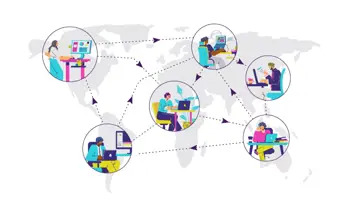How To Hire Remote Team Workers: Step-by-Step Guide
Remote work offers benefits to both employees and organizations, including flexibility, cost savings, and increased productivity. The time is ripe for revisiting your remote hiring procedures if you haven't done so. In this blog, Aniday will cover attracting, hiring remote team, and retaining top-quality remote employees.

What is Remote Hiring?
Remote hiring, also called remote recruiting, is the process of identifying, attracting, screening, interviewing, and hiring candidates to work outside the office. This can involve remote work from home, co-working spaces, or even overseas, where in-person meetings may never occur.
The benefits of hiring remotely

-
Access to a Worldwide Talent Pool
-
Cost Savings
-
Enhanced Productivity
-
Improved Work-Life Balance
-
Reduced Turnover
-
Impact on the Environment
-
Diverse Perspectives and Inclusivity
-
Scalability
-
Resilience and Continuity
-
Global Market Reach
How to Attract Remote Employees
The first step in hiring a remote team is attracting the right candidates. Here are some strategies to make your job openings more appealing:
1. Define Your Remote Work Culture
Candidates are increasingly looking for companies with a remote work culture that aligns with their values. Clearly define your remote work policies and company culture, including flexible schedules, communication expectations, and work-life balance. Highlight these in your job postings.
2. Offer Competitive Compensation
Competitive compensation is key to attracting top remote talent. Research industry standards and offer a competitive salary, taking into account location-based cost of living differences.
3. Emphasize Work-Life Balance
Remote workers often seek positions that offer a healthy work-life balance. Mention your commitment to work-life balance in your job descriptions and interviews.
4. Highlight Career Growth Opportunities
Make it clear that remote employees have the same career growth opportunities as in-house staff. Showcase your commitment to professional development and advancement within the company.
5. Craft Engaging Job Descriptions
Write detailed and engaging job descriptions that clearly explain the responsibilities, qualifications, and expectations of the role. Use action-oriented language and focus on the impact the candidate will have on the company.
How to Build a Strong Employer Brand Online
Your employer brand is crucial in remote hiring. It helps you stand out and attract top talent. Here's how to build a strong online employer brand:
1. Showcase Company Culture
Use social media, your company website, and platforms like Glassdoor to showcase your company culture. Share photos, stories, and testimonials from current remote employees.
2. Highlight Remote Work Success Stories
Share success stories of remote employees who have thrived in your organization. These testimonials can be powerful in attracting candidates who are considering remote positions.
3. Communicate Your Values
Share your company's core values and mission. Candidates often choose employers whose values align with their own.
4. Leverage Employee Advocacy
Encourage your current remote employees to advocate for your company online. Their endorsements can be more convincing than any marketing campaign.
5. Be Responsive
Respond promptly to enquiries and applications. A responsive and engaging online presence can be a huge draw for potential remote team members.
Selecting the Best Places to Post Remote Jobs

Choosing the right platforms to post your remote job openings is crucial. Here are some popular options:
1. Job Boards
Numerous job boards are exclusively focused on remote employment. Remote job listings are a specialty of platforms such as FlexJobs, We Work Remotely, and Remote.co. These platforms attract a high volume of remote job seekers.
2. General Job Boards
You can also post remote positions on popular general job boards like Indeed, LinkedIn, and Glassdoor. They have a wide reach and can attract candidates from various backgrounds.
3. Social Media
Utilize social media channels such as LinkedIn, Twitter, and Facebook for the dissemination of your job listings. You can use paid advertising to target specific remote work communities and regions.
4. Company Website
Make sure you have a dedicated careers page on your company website where you list all your job openings, including remote positions. Typically, this is the initial destination for candidates.
5. Networking
Leverage your professional network to find suitable candidates. Recommendations from reliable sources can result in top-tier hires.
How to Hire Remote Employees
Now that you've attracted potential candidates and built a strong online presence, it's time to start the hiring process. Here's a step-by-step guide:
1. Resume Screening
Review resumes and applications to shortlist candidates who meet the basic qualifications for the role. You can use applicant tracking systems (ATS) to streamline this process.
2. Initial Interviews
Conduct initial video interviews or phone screenings to assess candidates' skills, experience, and cultural fit. Ask behavioral and situational questions to gauge their suitability for remote work.
3. Skills Assessments
Depending on the role, administer skills tests or assignments to evaluate candidates' abilities. This step is critical to ensure they can perform the required tasks.
4. Check References
Reach out to the references supplied by candidates to confirm their work history and qualifications. This helps you confirm the accuracy of their claims.
5. Final Interviews
Hold final video interviews with the top candidates. Assess their remote work skills, such as communication, time management, and the ability to work independently.
6. Offer and Negotiate
Once you've identified your top candidates, extend offers and negotiate compensation and other terms of employment. Be prepared to discuss work hours, expectations, and communication preferences.
7. Onboarding
Develop a comprehensive onboarding process that includes training on remote work tools, company culture, and job-specific tasks. Provide all necessary resources and information to help your new hires succeed.
Remote Hiring Software

To streamline your remote hiring process, you can also invest in remote hiring software. These tools can help with applicant tracking, video interviews, skills assessments, and onboarding. Some popular remote hiring software options include:
-
Greenhouse: An applicant tracking system that streamlines the hiring process, from posting jobs to making offers.
-
Workable: A recruiting software that includes interview scheduling and collaboration features.
-
Trello: A project management tool that can be adapted for remote hiring workflows.
-
Zoom and Skype: Video conferencing tools for remote interviews.
-
Slack: For easy and effective communication with remote candidates and team members.
How to Retain Remote Employees
Hiring is only the beginning; retaining remote employees is equally important. Here are some tips for keeping your remote team engaged and satisfied:
1. Set Clear Expectations
Ensure that your remote employees know what is expected of them in terms of deliverables, deadlines, and communication. Clear guidelines will help prevent misunderstandings.
2. Provide Ongoing Support
Offer support and resources to your remote employees, including access to IT support, HR assistance, and other necessary services. Make sure they feel connected and supported.
3. Cultivate a Positive Remote Work Culture
Foster a sense of belonging and camaraderie among your remote team through virtual team-building activities, regular video meetings, and open communication channels.
4. Monitor Performance
Regularly assess the performance of your remote team members through periodic check-ins, performance reviews, and project milestones. Recognize and reward their achievements.
5. Address Legal and Tax Considerations
Ensure that you comply with relevant employment laws and tax regulations in both your location and the locations of your remote team members. Consult with legal and HR experts as needed.
TOP 10 common remote jobs to hire in 2023

Hiring for remote positions has become increasingly common across various industries. A growing number of jobs that were once office-based can now be completed remotely as the workplace continues to change. The following are some typical remote positions and roles that employers often look for:
1. Software Developers/Engineers
Remote software developers and engineers are in high demand. They work on building and maintaining software applications, websites, and systems. Many tech companies hire remote developers to access a wider talent pool.
2. Content Writers/Copywriters
Content creation is a crucial aspect of online marketing. Companies often hire remote content writers and copywriters to produce blog posts, web content, social media posts, and marketing materials.
3. Graphic Designers
Graphic designers can create visual assets for marketing campaigns, websites, and more from the comfort of their home offices. They collaborate with clients and teams online, making it an ideal role for remote work.
4. Digital Marketers
Digital marketing professionals, such as SEO specialists, social media managers, and PPC experts, are commonly hired for remote positions. They can strategize and manage online marketing campaigns from anywhere.
5. Customer Support Representatives
Many companies hire remote customer support representatives who provide assistance to customers via phone, email, or chat. They handle inquiries, solve problems, and ensure a positive customer experience.
6. Project Managers
Remote project managers oversee and coordinate various tasks, ensuring projects are completed on time and within budget. They collaborate with teams and clients using online project management tools.
7. Sales Representatives
Sales roles, including inside sales, account management, and business development, are often offered as remote positions. Salespeople use virtual communication tools to reach and engage with clients.
8. Virtual Assistants
Virtual assistants offer administrative support to businesses, entrepreneurs, and busy professionals. They manage schedules, handle email correspondence, and perform various tasks remotely.
9. Online Teachers and Tutors
With the growth of online education, remote teaching positions have surged. These roles encompass K-12 educators, college professors, language instructors, and subject-specific tutors.
10. Data Analysts
Data analysts collect, analyze, and interpret data to support decision-making processes. They work with data sets and provide insights into business operations, often from remote locations.
5 Common mistakes to avoid when hiring internationally
Expanding your business globally provides exciting opportunities for new markets and a diverse talent pool. However, it comes with unique challenges, especially in international hiring. Avoiding typical errors is essential for success. Here are five frequent errors to steer clear of when hiring internationally:
-
Neglecting Legal Compliance: International hiring involves complex legal requirements. Consult experts to avoid legal issues.
-
Underestimating Cultural Differences: Invest in cross-cultural communication to prevent misunderstandings and conflicts.
-
Disregarding Local Research: Research local markets thoroughly to align your hiring strategies.
-
Overlooking Compensation Adjustments: Adapt salaries to local standards to avoid dissatisfaction among international hires.
-
Neglecting Onboarding: Effective onboarding and integration processes are crucial to prevent isolation and enhance productivity among international employees.
Remote Hiring FAQs
Here are some frequently asked questions (FAQs) related to remote hiring:
1. What is the most important skill for remote team workers?
Effective communication is arguably the most important skill for remote team workers. Clear and timely communication ensures that remote employees stay connected and aligned with the company's goals and expectations.
2. How can I build trust with remote employees?
Building trust with remote employees requires consistent communication, setting clear expectations, and offering support. Trust is developed over time through reliable and transparent interactions.
3. How can I ensure remote employees are productive?
Productivity in remote teams can be encouraged through goal setting, performance tracking, and the use of project management tools. Regular check-ins and a focus on results rather than hours worked are also effective strategies.
Three Considerations When Hiring a Remote Team
Three key considerations when hiring a remote team are:
-
Cultural Fit: When hiring remote team workers, it's crucial to assess their cultural fit with your organization. Remote employees need to align with your company's values, mission, and remote work culture to thrive and contribute effectively.
-
Time Zone Management: If your remote team is spread across different time zones, consider using time zone management tools to schedule meetings and coordinate work effectively. Choose overlapping work hours when possible to enhance collaboration.
-
Diversity and Inclusion: Embrace diversity in your remote team. Different backgrounds, experiences, and perspectives can lead to innovative solutions and improved problem-solving. Ensure your hiring process is inclusive and considerate of various perspectives.
In summary, hiring remote team workers necessitates a strategic approach. Define your needs, attract the right candidates, build an online presence, choose the right platforms, and follow a structured hiring process. Prioritize employee retention for a motivated workforce. Aniday believes that hire remote team can be a significant advantage in today's dynamic work environment.
Aniday's HR Services
Headhunting Service
Find and recruit quality candidates in just 1 week! Supported by 40,000 experienced headhunters in IT, Finance, Marketing… capable of recruiting in any region.
Headhunting Service ➔Employer of Record (EOR) Service
On behalf of your business, we recruit employees and handle payroll without the need to establish a company in markets such as Vietnam, Singapore, Malaysia, India, Indonesia…
Employer of Record (EOR) Service ➔